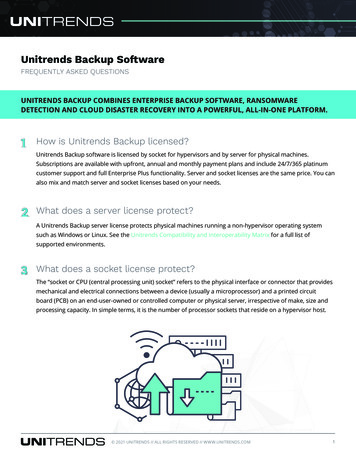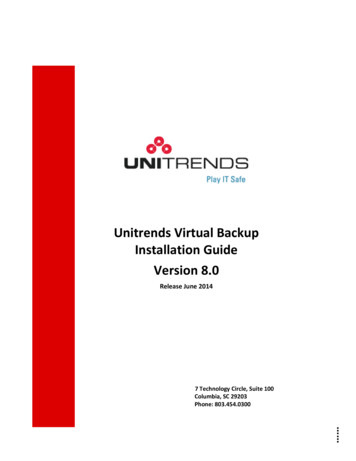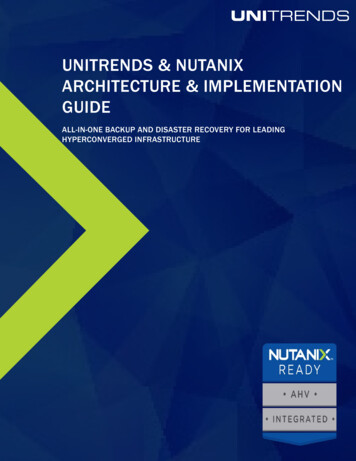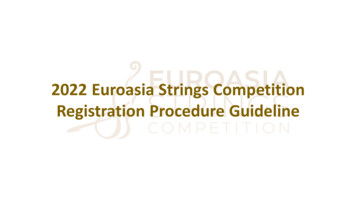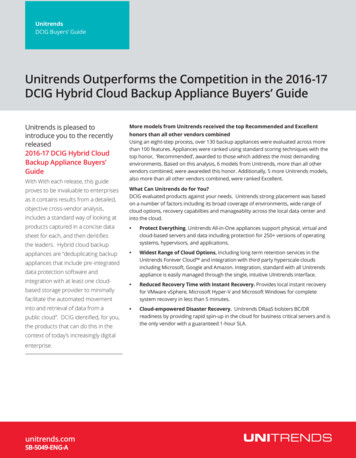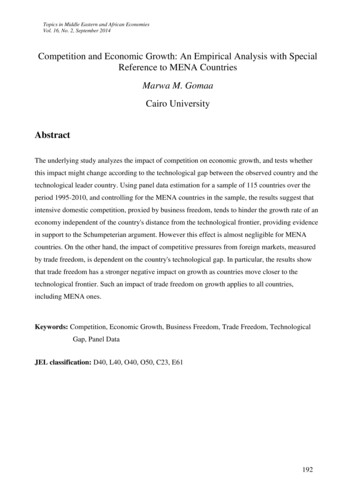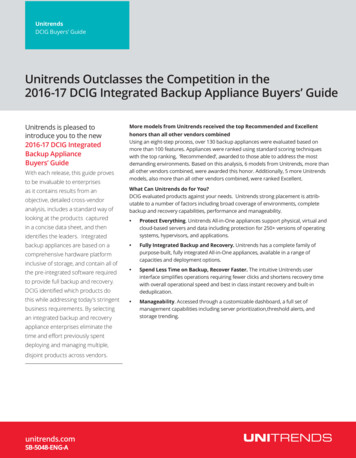
Transcription
UnitrendsDCIG Buyers’ GuideUnitrends Outclasses the Competition in the2016-17 DCIG Integrated Backup Appliance Buyers’ GuideUnitrends is pleased tointroduce you to the new2016-17 DCIG IntegratedBackup ApplianceBuyers’ GuideWith each release, this guide provesto be invaluable to enterprisesMore models from Unitrends received the top Recommended and Excellenthonors than all other vendors combinedUsing an eight-step process, over 130 backup appliances were evaluated based onmore than 100 features. Appliances were ranked using standard scoring techniqueswith the top ranking, ‘Recommended’, awarded to those able to address the mostdemanding environments. Based on this analysis, 6 models from Unitrends, more thanall other vendors combined, were awarded this honor. Additionally, 5 more Unitrendsmodels, also more than all other vendors combined, were ranked Excellent.analysis, includes a standard way ofWhat Can Unitrends do for You?DCIG evaluated products against your needs. Unitrends strong placement is attributable to a number of factors including broad coverage of environments, completebackup and recovery capabilities, performance and manageability.looking at the products captured Protect Everything. Unitrends All-in-One appliances support physical, virtual andcloud-based servers and data including protection for 250 versions of operatingsystems, hypervisors, and applications. Fully Integrated Backup and Recovery. Unitrends has a complete family ofpurpose-built, fully integrated All-in-One appliances, available in a range ofcapacities and deployment options. Spend Less Time on Backup, Recover Faster. The intuitive Unitrends userinterface simplifies operations requiring fewer clicks and shortens recovery timewith overall operational speed and best in class instant recovery and built-indeduplication. Manageability. Accessed through a customizable dashboard, a full set ofmanagement capabilities including server prioritization,threshold alerts, andstorage trending.as it contains results from anobjective, detailed cross-vendorin a concise data sheet, and thenidentifies the leaders. Integratedbackup appliances are based on acomprehensive hardware platforminclusive of storage, and contain all ofthe pre-integrated software requiredto provide full backup and recovery.DCIG identified which products dothis while addressing today’s stringentbusiness requirements. By selectingan integrated backup and recoveryappliance enterprises eliminate thetime and effort previously spentdeploying and managing multiple,disjoint products across vendors.unitrends.comSB-5048-ENG-A
The Insider’s Guide to EvaluatingIntegrated Backup Appliances2016-17INTEGRATED BACKUPAPPLIANCE BUYER’S GUIDEBy Charley McMaster and Ben MaasE M P O W E R I N G T H E I T I N D U S T R Y W I T H A C T I O N A B L E A N A LY S I S · W W W. D C I G . C O M
2016-17 INTEGRATED BACKUP APPLIANCE BUYER’S GUIDEThe Insider’s Guide to Evaluating Integrated Backup AppliancesTable of Contents1Introduction4Executive Summary6How to Use this Buyer’s Guide6Disclosures7Inclusion and Exclusion Criteria7The Eight-Step Process Used to Rank Products8DCIG Comments889991010DCIG Observations1010111214Virtual Machine TechnologiesEnable Rapid RecoveryVirtual and Physical Restore CapabilitiesGoing Beyond Backup and Recoveryto Unlock More ValueComplying with Regulatory RequirementsBest Practice Considerations: Understandthe Solution’s Impact on the WANPerformance and PricingGeneral ObservationsRecommended RankingExcellent RankingGood RankingIntegrated Backup Appliance Rankings17Integrated Backup Appliance 394041424344454647484950Barracuda Networks Barracuda Backup 995Barracuda Networks Barracuda Backup 1090Cohesity C2300Cohesity C2500Commvault A210Commvault A410Commvault A600Infrascale Data Protection Appliance 9500Quest DL4300 Backup and Recovery Appliance (High Capacity)Quest DL4300 Backup and Recovery Appliance (Standard Edition)Quorum onQ-260-22Quorum onQ-280-32Quorum onQ-288-32Rubrik r344Rubrik r348Rubrik r528STORServer A740-CVSTORServer A740-TSMSTORServer EBA 2802-CVSTORServer EBA 2802-TSMUnitrends Recovery 603Unitrends Recovery 604Unitrends Recovery 713SUnitrends Recovery 714SUnitrends Recovery 814SUnitrends Recovery 824SUnitrends Recovery 933SUnitrends Recovery 936SUnitrends Recovery 943SUnitrends Recovery 944SUnitrends Recovery 946SVeritas NetBackup 5240Veritas NetBackup 5330AppendicesA-1 Appendix A—Definitions, Explanations and TerminologyB-1 Appendix B—Vendor Contact InformationC-1 Appendix C—DCIG Contact InformationThis Buyer’s Guide Edition is licensed to Unitrends with unlimited and unrestricted distribution rights through December 31, 2017. 2016 DCIG, LLC. All rights reserved.i
2016-17 INTEGRATED BACKUP APPLIANCE BUYER’S GUIDEThe Insider’s Guide to Evaluating Integrated Backup AppliancesIntroductionData protection is an essential yet oftentimes laborious and time-consuming task that everyorganization must perform successfully or put the organization’s very existence at risk.Ever-increasing data volumes, combined with ever-shrinking RPO/RTO windows, straincorporate data protection abilities and create a need for new solutions.Integrated backup appliances address all of these challenges by providing a pre-integrated,self-contained purpose-built backup appliance solution. Once largely assembled andconfigured by either IT staff or value added resellers, integrated backup appliances havegone mainstream and are ready for use in almost any size enterprise.The backup appliance market is dynamic. In the two years since DCIG published theDCIG 2014-15 Integrated Backup Appliance Buyer’s Guide: New vendors have entered the market Existing vendors have introduced new products based on more powerful hardware;delivering more performance and capacity to keep up with ever growing enterprisedata protection requirements Vendors have released new software features to provide more benefits to end users,blurring the boundaries between traditional product categories; even extending intoother secondary storage use cases such as copy data management, test/dev, dataanalytics and file servicesThe backup appliance market is growing. This is part of an ongoing shift toward preintegrated appliance-based solutions that can be rapidly deployed into the enterprise datacenter through largely non-disruptive plug-and-play installations. In fact, according to IDC,worldwide purpose-built backup appliance (PBBA) factory revenues grew 11.5% year overyear, and capacity shipped increased 35.3% to 1 exabyte since 2Q15.1DCIG evaluates PBBA products based on three primary use cases: Deduplicating backup appliances are sometimes referred to as disk backup targetappliances. These appliances displace legacy backup targets and seamlessly fit intoexisting data protection schemes. Their optimized deduplication technologies reducebackup storage consumption by up to 20x while accelerating the backup process.These appliances typically work with a variety of backup applications, though most ofthese products only integrate with the provider’s own data protection software toaccelerate backups. Hybrid cloud backup appliances include pre-integrated data protection software andsupport at least one cloud-based storage provider. A hybrid cloud backup appliance’sability to replicate and retrieve backups to and from the cloud supports disaster recoveryneeds and provides essentially infinite storage capacity. In the hybrid cloud backup usecase, solutions are evaluated based on their ability to protect data in conjunction with acloud storage provider. Integrated backup appliances are backup appliances that include pre-integrated dataprotection software. Integrated backup appliances displace both legacy backup targetsand legacy backup software. Every integrated backup appliance featured in this Buyer’s1. Worldwide Purpose-Built Backup Appliance (PBBA) Market . - IDC.” 2016. 29 Sep. 2016 https://www.idc.com/getdoc.jsp?containerId prUS41628016 This Buyer’s Guide Edition is licensed to Unitrends with unlimited and unrestricted distribution rights through December 31, 2017. 2016 DCIG, LLC. All rights reserved.1
2016-17 INTEGRATED BACKUP APPLIANCE BUYER’S GUIDEThe Insider’s Guide to Evaluating Integrated Backup AppliancesIntroduction(continued)Guide can also function as a hybrid cloud backup appliance, but the Integrated backupappliance use case is the focus of this Buyer’s Guide. In the integrated backup appliance use case, solutions are evaluated based on their ability to protect data behind thecorporate firewall.Organizations that have outgrown the capabilities of their legacy data protection solutionswill discover a large number of vendors and products vying to become their next generation solution. Thoroughly researching the many available products has become too timeconsuming and costly to be feasible for many organizations. The DCIG 2016-17 IntegratedBackup Appliance Buyer’s Guide solves this problem.DCIG’s analysts have already done the heavy lifting for enterprise technology buyers by: Identifying a common technology need with many competing solutions but with littlecomparative data available to technology purchasers Scanning the environment to identify available products in the marketplace Gathering normalized data about the features each product supports Providing an objective, third-party evaluation of those features from anend-user perspective Describing key product considerations and important changes in the marketplace Presenting DCIG’s opinions and product feature data in a way that facilitates rapidfeature-based comparisonsThe Value This DCIG Buyer’s Guide Creates for BuyersIt is in this context that DCIG presents its 2016-17 Integrated Backup Appliance Buyer’sGuide. The level of detail in this Buyer’s Guide, combined with DCIG’s consistent rankingsystem, helps organizations in two key ways:First, it provides a powerful yet concise method to evaluate each product so organizationscan understand the overall strengths and weaknesses of each one. Using this information,evaluators can better align the specific needs of their environment with the features available on each appliance.Second, this Buyer’s Guide provides a concise one-page data sheet for each product. Thedata sheets drill down into the specifics of each product to provide information on virtualization, management, backup and recovery, replication, hardware and support features. Thesefeature areas contribute the overall ranking for each product.The DCIG 2016-17 Integrated Backup Appliance Buyer’s Guide is based on a pool of morethan 130 products in DCIG’s backup appliance body of research. DCIG analysts rankedintegrated backup appliances based on an evaluation of more than 100 different features.The thirty-three (33) appliances from ten (10) vendors that met the inclusion criteria andachieved a ranking of Recommended, Excellent or Good are included in this Buyer’s Guide.Please note that this Buyer’s Guide is NOT intended to be a substitute for internal testing. DCIG encourages any organization that is considering the purchase of an integratedbackup solution to do its own in-house testing if at all possible as it is impossible for DCIGto predict how well the appliance will perform in every environment.This Buyer’s Guide Edition is licensed to Unitrends with unlimited and unrestricted distribution rights through December 31, 2017. 2016 DCIG, LLC. All rights reserved.2
2016-17 INTEGRATED BACKUP APPLIANCE BUYER’S GUIDEThe Insider’s Guide to Evaluating Integrated Backup AppliancesIntroduction(continued)We hope this Buyer’s Guide meets its intended purposes in your environments and servesas a helpful aid in supplementing and expediting your organization’s normal decisionmaking and product evaluation process.As a supplement to the downloadable Buyer’s Guide, end users registering to access thisreport via the DCIG Analysis Portal also gain access to the DCIG Interactive Buyer’s Guide(IBG). The IBG enables organizations take the next step in the product selection processby generating custom reports, including comprehensive side-by-side feature comparisonsof the products in which the organization is most interested. See www.dcig.com to learnmore about the DCIG Analysis Portal.Charley and BenThis Buyer’s Guide Edition is licensed to Unitrends with unlimited and unrestricted distribution rights through December 31, 2017. 2016 DCIG, LLC. All rights reserved.3
2016-17 INTEGRATED BACKUP APPLIANCE BUYER’S GUIDEThe Insider’s Guide to Evaluating Integrated Backup AppliancesExecutiveSummaryEnterprises now demand higher levels of automation, integration, simplicity, and scalabilityfrom every component deployed into their IT infrastructures. The integrated backup appliances found in this Buyer’s Guide are a clear reflection of those expectations. Intended forenvironments that want to protect applications and data and then keep it behind corporatefire walls, these backup appliances come fully equipped to do so from both hardware andsoftware perspectives.Once largely assembled and configured by either IT staff or value added resellers, integrated backup appliances have gone mainstream and are ready for use in almost any sizeenterprise, with the integrated backup appliances covered in this Buyer’s Guide specificallywell suited for large enterprises. By bundling together both hardware and software, largeenterprises get the type of turnkey backup appliance solution that was just a few years agoprimarily reserved for smaller organizations. In so doing, large enterprises can eliminate theneed to spend days, weeks, or even months they previously had to spend configuring anddeploying these solutions into their infrastructure.The evidence of the demand for backup appliances at the large enterprise level is madeplain by the providers who bring them to market. Once the sole domain of providers such asSTORServer and Unitrends, “software only” companies such as Commvault and Veritas haveresponded to large enterprise expectations for turnkey solutions with both now offering theirown backup appliances under their respective brand names.As a result, even large enterprises may get any of the most feature-rich enterprise backupsoftware solutions on the market, whether it is IBM’s Spectrum Protect (STORServer),Commvault (Commvault and STORServer), Unitrends or Veritas NetBackup, delivered tothem as a pre-integrated backup appliance. The enterprise backup software on these backupappliances then goes hand-in-glove with the enterprise caliber hardware on which they run.In short, enterprise backup appliances deliver the out-of-box and implementation experiencethat large enterprise have long sought, coupled with the hardware and software featuresthey demand and expect when protecting data in their environments.Evidence of this may be seen in the number of integrated backup appliances (11) that DCIGranks as Recommended. In this Buyer’s Guide both STORServer and Unitrends offer multiplebackup appliance models that achieved a Recommended ranking. The growing number ofintegrated backup appliances ranked as Recommended reflects the fact that these providersfully understand the type of hardware and software functionality that large enterprises expectthese appliances to possess and deliver.But behind the scenes new business demands are driving changes to backup applianceswhich enterprises should consider: First, enterprises expect successful recoveries. A few years ago, the concept of allbackup jobs completing successfully was enough to keep everyone happy and givinghigh-fives to one another. No more. The focus has shifted to rapid and reliable recovery.Enterprises recognize that they have reliable backups residing on a backup appliancewhich may largely sit idle during off-backup hours. This gives the enterprise some freedomto do more with these backup appliances during these periods of time such as testingrecoveries, recovering applications on the appliance itself, or even presenting thesebackup copies of data to other applications to use as sources for internal testing andThis Buyer’s Guide Edition is licensed to Unitrends with unlimited and unrestricted distribution rights through December 31, 2017. 2016 DCIG, LLC. All rights reserved.4
2016-17 INTEGRATED BACKUP APPLIANCE BUYER’S GUIDEThe Insider’s Guide to Evaluating Integrated Backup AppliancesExecutive Summary(continued)Executive Summarydevelopment. This is evidenced by the large number of backup appliances that support(continued)one or more vCenter Instant Recovery features and the emerging crop of backupappliances that can also host virtual machines and recover applications on the appliances. Second, enterprises want greater visibility into their data to justify businessdecisions. The amount of data residing in enterprise backup repositories is staggering.Yet the lack of value that enterprises derive from that stored data combined with thepotential risk it presents to them by retaining it is equally staggering. Features that grantgreater visibility into this stored data which then analyze it and help turn this dormant datainto measurable value for the business are already starting to find their way onto theseappliances. Expect these features to become more prevalent in the years to come. Third, enterprises want backup appliances to expand their value proposition. Thecore value proposition of integrated backup appliances is that they provide an easy todeploy yet robust backup and recovery solution. But the current generation of appliancesare powerful enough to do much more, and new use cases are constantly emerging forthese appliances. These uses may extend to all secondary storage uses including copydata management, archiving, test/dev, data analytics and even file services. Theseextended use cases may create substantial additional value for organizations that take fulladvantage of the related product capabilities.Emerging providers such as Cohesity—which is making its first appearance as an integratedbackup appliance vendor—directly address these opportunities. Cohesity’s founder is MohitAron, who previously co-founded Nutanix. Cohesity is using backup target as a beachheadin the enterprise, but aims to provide hyperconverged storage for all secondary storage usecases. Available as a scale-out backup appliance, it provides an example of how enterprisescan more easily scale and maintain data protection infrastructures over time, while gainingthe flexibility to use the system for more than just data protection.This DCIG 2016-17 Integrated Backup Appliance Buyer’s Guide highlights the most robustand feature rich integrated backup appliances available on the market today. As such, largeenterprises should consider any of the backup appliances covered in this Buyer’s Guide ashaving many if not all of the features needed to protect both their physical and virtual environments as well as giving them early access to the new set of features that will define thenext generation of integrated backup appliances.This 2016-17 Integrated Backup Appliance Buyer’s Guide accomplishes the following objectives: Provides an objective, third-party evaluation of products that evaluates and ranks theirfeatures from an end user’s viewpoint Includes recommendations on how to best use this Buyer’s Guide and the productscontained in it Evaluates the features of each product based upon criteria that matter most so end userscan quickly know which appliance is most appropriate for them Provides a standardized data sheet for each product so end users can do quickcomparisons of the features supported and not supported on each product Gives any organization the ability to request competitive bids from different providersThis Buyer’s Guide Edition is licensed to Unitrends with unlimited and unrestricted distribution rights through December 31, 2017. 2016 DCIG, LLC. All rights reserved.5
2016-17 INTEGRATED BACKUP APPLIANCE BUYER’S GUIDEThe Insider’s Guide to Evaluating Integrated Backup AppliancesHow to Use this Buyer’s GuideThis Buyer’s Guide is intended to help users accelerate theirproduct research and selection process—driving cost outof the research process while simultaneously increasingconfidence in the results. The purpose of this Buyer’s Guideis NOT to tell users exactly which product(s) to purchase.Rather, it is to help guide them in coming up with a short listof competitive products that have comparable features thatmeet their specific needs.Just because a product ranks well does not automatically mean that it is the right product for an organization.If anything, because of the scope of the products evaluated and analyzed, it may have features that are too robustfor the needs of an individual department or organization.However, this Buyer’s Guide does give organizations somesense of how each product compares to other productscovered in this Guide, as well as offers additional insight intowhat product offerings are available on the market.DCIG recommends that organizations use this Buyer’sGuide in the following seven ways:1. Eliminate the painstaking research normally associated with identifying a short list of products that meettheir needs. DCIG analysts dug through product websites, reports and product manuals to uncover more than100 features supported by the thirty-three (33) productsfrom ten (10) different storage providers in this Buyer’sGuide. A glance at the resulting ranking sheet revealshow complete the features of each product are comparedto the other products. A look at the corresponding datasheet reveals whether or not a product supports thefeatures required to make it onto a particular organization’s short list for further consideration.2. Do apples-to-apples comparisons of products fromdifferent vendors. It behooves an organization to getcompetitive bids from multiple vendors. After all, whenthey compete, you win! But that tactic only works wellwhen organizations know that they are receivingcompetitive bids on products that are roughly comparable. Using this Buyer’s Guide, organizations can doa better job of accomplishing that objective.3. Separate the apples from the oranges. Just asimportant as doing apples-to-apples comparisons isidentifying when an orange is thrown into the mix.Sometimes it is very difficult for an organization to knowif it is truly getting a good deal when bids come in fromvendors that include different products. Now organizations can refer to the rankings of each product on thisguide so they know when they are getting a good deal,a great deal or just a “so-so” one.4. Gain perspective on how products from lesswell-known vendors compare against establishedand better-known brands. There’s a built-in level ofcomfort when buying products from well-knownvendors. There’s also a built-in resistance to buyingproducts from vendors that are perceived as unknownquantities. This Buyer’s Guide helps to remove some ofthat apprehension. Using this Buyer’s Guide, organizations can see how these products stack up.5. Normalize complex terminology. Every industry has aproclivity to adopt acronyms and jargon that is specificto it. This Buyer’s Guide sifts through the acronyms andjargon and then normalizes these terms, providing afoundation for meaningful comparisons. Definitions forthese normalized terms are provided in the Glossaryin this Guide.6. Take advantage of standardized data sheets toquickly compare products side-by-side. The productdata sheets available from the different vendors are rarelylaid out in the same way or contain the same information.Some vendors even have data sheet formats that varyfrom product to product within their own portfolio. ThisBuyer’s Guide tackles this problem by creating astandard, easy-to-read data sheet for every product. Inthis way, product data sheets for individual products canbe printed out and laid down side by side so that thefeatures on them can be quickly compared.7. Help justify buying recommendations to businessteams. An overall ranking of Recommended, Excellentor Good is included at the top of every product datasheet. This overall ranking summarizes in a single wordhow feature-rich a product is compared to the otherproducts in the Buyer’s Guide.DisclosuresOver the last few years the general trend in the US has beenfor both large and boutique analyst firms to receive some orall of their revenue from vendors. DCIG is no different in thisrespect as it also receives payment for the different servicesit performs for vendors. The services that DCIG providesThis Buyer’s Guide Edition is licensed to Unitrends with unlimited and unrestricted distribution rights through December 31, 2017. 2016 DCIG, LLC. All rights reserved.6
2016-17 INTEGRATED BACKUP APPLIANCE BUYER’S GUIDEThe Insider’s Guide to Evaluating Integrated Backup Appliancesinclude blogging, customer validations, product reviews,executive white papers, special reports and white papers.In the interest of transparency, a number of the vendorsincluded in this DCIG Buyer’s Guide are or have been DCIGclients. This is not to imply that their products were givenpreferential treatment in the Buyer’s Guide. All it means is thatDCIG had more knowledge of their products so that DCIGcould consider their product for inclusion in this Buyer’s Guide.In that vein, there are a number of important facts to keepin mind when considering the information contained in thisBuyer’s Guide and its merit. No vendor paid DCIG any fee to research this topic orarrive at pre-determined conclusions. DCIG did not guarantee any vendor that its productwould be included in this Buyer’s Guide DCIG did not imply or guarantee that a specific productwould receive a preferential ranking in this Buyer’s Guide,before or after completion of research All research was based upon publicly available information, information provided by the vendor, and/or theexpertise of those evaluating the information No negative inferences can be drawn against any vendornot included in the Buyer’s Guide It is a misuse of the Buyer’s Guide to make comparisonsbetween any vendor not ranked in the Buyer’s Guideversus any vendor ranked in the Buyer’s GuideBecause of the number of features analyzed and weighed,there was no way for DCIG to accurately predict at theoutset how individual products would end up ranking. DCIGwants to emphasize that no vendor was privy to how DCIGweighed individual features. In every case, the vendor onlyfound out the rankings of its product(s) after the analysiswas complete.Inclusion and Exclusion CriteriaThe DCIG 2016-17 Integrated Backup Appliance Buyer’sGuide is based on DCIG’s Backup Appliance Body ofResearch on more than 130 backup appliances. The following criteria were used when determining whether or not toinclude as a specific storage array in this Buyer’s Guide: Be available as a physical appliance that includesbackup and recovery software as a combined bundleunder one SKU May ship as a virtual appliance Stores backup data on the appliance via on premiseDAS, NAS or SAN-attached storage May connect to a public storage cloud Sufficient information provided to reach meaningfulconclusions Be formally announced or generally available forpurchase on July 1, 2016Ultimately, it is the professional judgment of the analystsworking on each DCIG Buyer’s Guide whether or not aparticular model meets the inclusion criteria.The Eight-Step ProcessUsed to Rank ProductsTo rank each product included in this Buyer’s Guide, DCIGwent through an eight-step process to come to the mostobjective conclusion possible.1. DCIG established which features would be evaluatedand which ones would not. Prior to selecting thefeatures which would be evaluated, DCIG quantified,then “normalized” the list of available features such thata common name for each feature was established. Incases where a feature could not be objectively definedor understood, it was excluded from consideration.2. The features were grouped into six (6) general categories. The features to be evaluated were grouped into sixgeneral categories: Appliance Information, Virtualization,Replication Management, Hardware, Backup &Recovery, and Management.3. DCIG completed a survey for each vendor’s product(s)and then sent the survey(s) to each vendor for verification. Each vendor was invited to review their data andrespond with any corrections or edits to the DCIGcompleted survey(s). In every case, every vendor hadthe opportunity to review and respond to any DCIGcompleted survey.4. DCIG identified a list of products that met the DCIGdefinition for “Integrated Backup Appliances” based onthe inclusion/exclusion criteria.5. DCIG weighted each feature to establish a scoringrubric. The weighting of each feature was done by ateam of DCIG research analysts. The weightings wereThis Buyer’s Guide Edition is licensed to Unitrends with unlimited and unrestricted distribution rights through December 31, 2017. 2016 DCIG, LLC. All rights reserved.7
2016-17 INTEGRATED BACKUP APPLIANCE BUYER’S GUIDEThe Insider’s Guide to Evaluating Integrated Backup Appliancesused to reflect if a feature was supported and potentially how useful and/or important the feature wasto end users.6. Each product’s features were scored based oninformation gathered in the surveys. Features weremarked as either “supported” or “unsupported/undetermined” and then scored accordingly. Rankingswere finalized after any updates from vendors had beenentered and the review period expired.7. Products were ranked using standard scoring techniques. One of the goals of this Buyer’s Guide is toestablish clear lines of differentiation with conclusionsthat are arrived at objectively. To accomplish this goal,the mean or average score for all products was firstdetermined and then the standard deviation. DCIGdeveloped an overall ranking for each product basedon where that product’s overall score fit into standarddeviatio
existing data protection schemes. Their optimized deduplication technologies reduce backup storage consumption by up to 20x while accelerating the backup process. These appliances typically work with a variety of backup applications, though most of these products only integrate with the provider's own data protection software to accelerate .


